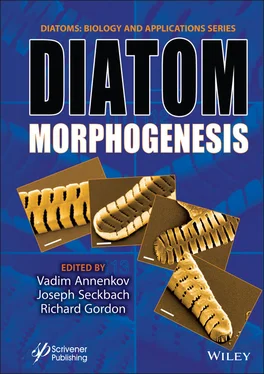Diatom Morphogenesis
Здесь есть возможность читать онлайн «Diatom Morphogenesis» — ознакомительный отрывок электронной книги совершенно бесплатно, а после прочтения отрывка купить полную версию. В некоторых случаях можно слушать аудио, скачать через торрент в формате fb2 и присутствует краткое содержание. Жанр: unrecognised, на английском языке. Описание произведения, (предисловие) а так же отзывы посетителей доступны на портале библиотеки ЛибКат.
- Название:Diatom Morphogenesis
- Автор:
- Жанр:
- Год:неизвестен
- ISBN:нет данных
- Рейтинг книги:5 / 5. Голосов: 1
-
Избранное:Добавить в избранное
- Отзывы:
-
Ваша оценка:
- 100
- 1
- 2
- 3
- 4
- 5
Diatom Morphogenesis: краткое содержание, описание и аннотация
Предлагаем к чтению аннотацию, описание, краткое содержание или предисловие (зависит от того, что написал сам автор книги «Diatom Morphogenesis»). Если вы не нашли необходимую информацию о книге — напишите в комментариях, мы постараемся отыскать её.
A unique book presenting the range of silica structures formed by diatoms, theories and hypotheses of how they are made, and applications to nanotechnology by use or imitation of diatom morphogenesis.
Audience
Diatom Morphogenesis — читать онлайн ознакомительный отрывок
Ниже представлен текст книги, разбитый по страницам. Система сохранения места последней прочитанной страницы, позволяет с удобством читать онлайн бесплатно книгу «Diatom Morphogenesis», без необходимости каждый раз заново искать на чём Вы остановились. Поставьте закладку, и сможете в любой момент перейти на страницу, на которой закончили чтение.
Интервал:
Закладка:
Furthermore, diatom valves seem to have a complex inner ultrastructure that cannot be understood completely by observing the internal and external view of a given valve surface using the previously mentioned tools. Although the multilayer, multiscalar porosity can be observed easily using such techniques, the internal anatomy and relations of the siliceous elements of the frustule cannot be understood [1.41]. It was usual to wish that the observation of a broken valve or girdle band at the right site and right angle would help, otherwise, the complex inner structure remained unseen [1.41].
Thus, another advanced method was required for understanding the inner structures and spatial relationships of the siliceous elements of a given diatom frustule. The FIB-SEM was introduced as a solution for such a problem by cutting the diatom frustule parts at nanoresolution to reveal the inner complex ultrastructure of a given valve or frustule (Figure 1.6) [1.41]. Suzuki et al . [1.40] was the first work introduced using FIB-SEM for making a cross-section in diatoms. Only a few articles are available using FIB-SEM and the field is still growing. The acquired data using FIB-SEM could be used to reconstruct the overall 3D geometry of diatoms to carry out further computational simulations necessary for diatom nanotechnology applications.
Table 1.1 A summary of the major tools used to study diatom frustule morphology and its ultrastructure.
| LM | TEM | SEM | AFM | FIB-SEM | |
| The date of first known observation of diatoms using the tool | Anonymous, 1703 [1.22] | Krause, 1936 [1.27] | Mid of 1960s [1.24] | Linder et al ., 1992 [1.33] | Suzuki et al ., 2001 [1.40] |
| Up-to-date resolution | The maximum resolution of the common compound optical microscope can be around 200 nm. Recently, the resolution was enhanced (down to 97 nm) using special kind of lenses [1.37]. | Up-to-date, the highest TEM resolution could be down to 50 picometer or even lower [1.29]. | The details less than 15 nm was not resolved under most of SEMs. Recently, an outbreak has been achieved, and the resolution of SEM could be below 1 nm [1.39]. | Recently, the resolution can be below 1 nm. | Having SEM as the microscope part of the device. Thus, the resolution is dependent on this SEM. |
| When we should use? | Observation of the presence or absence of diatoms in a sample. Identification of diatoms on the genus level. Enumeration of diatom frustules for different purposes. | Observation of the fine porosity (mesopores) present in some genera, like raphid pennates (Figure 1.5b).Observation of thin cross-sections in a valve or a girdle band.Observation of the cytoplasmic components of thin cross-sections of living cells (living cells anatomy). | Observation of the outer ultrastructure including most porosity.Observation of the overall 3D ultrastructure of the frustule or different parts.Identification at the species and subspecies level. | Observation of the 3D topology of a diatom frustule or its components.Measuring forces related with both living diatoms and its cleaned frustules. | Understanding the inner ultrastructure of diatom frustule or its parts by cutting cross-sections through it.Observation of the siliceous elements structural relations within the frustule.Observation of the whole 3D ultrastructure of the frustule via the 3D reconstruction. |
| The disadvantages | The observations for most of the ultrastructure details will be limited. Either the girdle view or the valve view will be available. | Only the tiniest parts of the valve, like pore occlusions, will be observed.The high energy electron beam may damage some sensitive samples, so it should be used wisely. | The samples must be coated with a conductive layer, which in turn could change the nano texture of the frustule silica and probably pore sizes, thus the thickness and smoothness of the conductive layer should be optimized and be thin as possible without getting nanoparticles on the top.The high energy electron beam may also damage some sensitive samplesThe regular resolution keep the pore occlusions of very fine porosity (below 10 nm) hidden. | The frustules must fix to the substrate before measuring.A very sensitive tool with complicated precautions to follow to get the desired results. | This technique sometimes needs more sophisticated preparation of the samples and more sophisticated work to reconstruct the frustule or its parts, however it worth.Related with the presence of the device, which usually is not available for all research groups. |
Finally, all the techniques mentioned were summarized in Table 1.1to help beginners and students choose between different tools on-demand.
1.3 Diatom Frustule 3D Reconstruction
Toward the complete understanding of the 3D structure of a given diatom frustule, a comprehensive 3D model can be created from the data collected from different characterization techniques. This approach, which is designated as the 3D reconstruction of diatom frustules, can be used for different purposes but is mainly for computer modeling. Oncoming tools for the 3D reconstruction of diatom frustules are FIB-SEM [1.32, 1.42] and digital holographic microscopy (DHM) combined with SEM [1.30]. The combination of DHM and SEM or AFM might give the ability to model and visualize microscopic 3D objects with a high resolution in all directions [1.30]. Hildebrand et al . [1.32] introduced the ability for the 3D reconstruction of subcellular architecture using FIB-SEM with new insights into the architecture and synthesis process of both the siliceous and organic components inside the cell. Xing et al . [1.42] is an inspiring reference for the 3D reconstruction of diatom frustule using the 2D image series resulting from FIB-SEM.
1.3.1 Recommended Steps to Understand the Complex Diatom Morphology: A Guide for Beginners
1. Fresh samples, if available, which means the sample is not diatomite (i.e., the fossil form of diatom frustules) [1.31], allow evaluation of the physiological state of the population at the time of collection. The features of living cells might help in the identification process, through the descriptions of colonial forms, cell attachment, extruded materials, plastids, and nucleus position (for instance see Figures 1.1 and 1.2). Since diatom frustules are rigid silica, they appear from two different viewpoints, the girdle view (from the side) and the valve view (from the front) under LM Figure 1.4. Some genera are easily identifiable in girdle view, such as Mastogloia and Amphora pediculus (Kütz.) Grunow, others are not. Lately, confocal microscopy uses are very promising [1.3, 1.13], also combining microscopic and molecular information allowed reclassification of a population in culture annotated as a radial centric species related to Leptocylindrus danicus Cleve, as an araphid pennate species in the staurosiroid lineage, within the genus Plagiostriata [1.14].
2. The selection of the suitable cleaning procedure, depending on the source of diatoms, is a crucial step to extract the siliceous frustule parts. Routinely, diatoms are identified and enumerated without their protoplasts where striae morphology & number, raphe shape, and other morphological characteristics could be verified for identification (details in Figures 1.3b and 1.4). Among the best guides for the cleaning process could be Wang et al . [1.43]. More gentle cleaning methods (e.g., H 2O 2method) should be considered in case we need to preserve mesopores (i.e., fine pores with diameters ranging from 50 to 3 nm that present on pore occlusions, which cover the areolae from inside or outside [1.48]) especially within genera, such as raphid pennate diatoms (Figure 1.5b).
Читать дальшеИнтервал:
Закладка:
Похожие книги на «Diatom Morphogenesis»
Представляем Вашему вниманию похожие книги на «Diatom Morphogenesis» списком для выбора. Мы отобрали схожую по названию и смыслу литературу в надежде предоставить читателям больше вариантов отыскать новые, интересные, ещё непрочитанные произведения.
Обсуждение, отзывы о книге «Diatom Morphogenesis» и просто собственные мнения читателей. Оставьте ваши комментарии, напишите, что Вы думаете о произведении, его смысле или главных героях. Укажите что конкретно понравилось, а что нет, и почему Вы так считаете.












